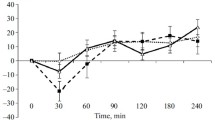Summary
The selectivities of morphine, codeine, l-methadone and d-propoxyphene, towards the binding sites in mouse brain membranes labelled by 3H-dihydromorphine (DHM), 3H-ethylketocyclazocine (EKC) and 3H-D-Ala2-Leu5-enkephalin (DALE), were investigated. Of the four binding sites identified, three correspond to mu-, kappaand delta-opioid binding sites or receptors, respectively. The fourth site has a high capacity and binds EKC with a high affinity, DHM with a very low affinity and does not bind DALE. In displacement studies, the relative affinities of morphine and methadone were quite similar towards the tree sites with highest affnity (mu ≫ kappa ≫ delta). Codeine and d-propoxyphene were mu-selective but did not differentiate between kappa-and delta-sites. At high concentrations I-methadone (Kd=6.7 μM), and d-propoxyphene (Kd=40 μM) bound to the fourth site, while morphine, codeine and naloxone were practically inactive. The binding selectivities of these drugs were quite different from those of metkephamid and U-50, 488 H, substances that are thought to exert their antinociceptive effects through delta-and kappa-receptors, respectively. It was concluded that while d-propoxyphene and codeine may partly act througg other receptors than morphine, this is probably not the case for l-methadone.
Similar content being viewed by others
References
Adler TK (1963) The comparative potencies of codeine and its demethylated metabolites after intraventricular injection in the mouse. J Pharmacol Exp Ther 140:155–161
Carroll MN, Lim RKS (1960) Observations on the neuropharmacology of morphine and morphinelike analgesia. Arch Int Pharmacodyn 75:383–403
Chavkin C, Goldstein A (1982) Reduction in opiate receptor reserve in morphine tolerant guinea-pig ilea. Life Sci 31:1687–1690
Ciafolo FR (1979) Methadone binding at nonopiate receptor binding sites. Res Commun Chem Pathol Pharmacol 24:419–430
Fraser HF, Isbell H (1960) Pharmacology and addition liability of dl-and d-propoxyphene. Bull Narcotics 12:9–14
Frederickson RCA, Smithwick EL, Shuman R, Bemis KG (1981) Metkephamid, a systemically active analog of methionine enkephalin with potent opioid δ-receptor activity. Science 211:603–605
Gray EG, Whittaker VP (1962) The isolation of nerve endings from brain: An electron-microscopic study of cell fragments derived by homogenization and centrifugation. J Anat (Lond) 96:79–88
Hynes MD, Frederickson RCA (1982) Cross-tolerance studies distinguish morphine-and metkephamid-induced analgesia. Life Sci 31:1201–1204
Kosterlitz HW, Paterson SJ (1980) Characterization of opioid receptors in nervous tissues. Proc R Soc Lond B 210:113–122
Kosterlitz HW, Lord JAH, Watt AJ (1972) Morphine receptor in the myenteric plexus of the guinea-pig. In: Kosterlitz HW, Collier HOJ, Villarreal JE (eds) Agonist and antagonist actions of narcotic analgesic drugs. Macmillan, London, pp 45–61
Kosterlitz HW, Paterson SJ, Robson LE (1981) Characterization of the x-subtype of the opiate receptor in the guinea-pig brain. Br J Pharmacol 73:939–949
Lahti RA, VonVoigtlander PF, Barsuhn C (1982) Properties of a selective kappa agonist, U-50,488H. Life Sci 31:2257–2260
Ling GSF, Pasternak GW (1983) Spinal and supraspinal opioid analgesia in the mouse: The role of subpopulations of opioid binding sites. Brain Res 271:152–156
Lord JAH, Waterfield AA, Hughes J, Kosterlitz HW (1977) Endogenous opioid peptides: Multiple agonist and receptors. Nature (Lond) 267:495–499
Magnan J, Paterson SJ, Tavani A, Kosterlitz HW (1982) The binding spectrum of narcotic analgesic drugs with different agonist and antagonist properties. Naunyn-Schmiedeberg's Arch Pharmacol 319:197–205
Martin WR (1967) Opioid antagonists. Pharmacol Rev 19:463–521
Martin WR, Eades CG, Thompson JA, Huppler RE, Gilbert PE (1976) The effects of morphine-and nalorphine-like drugs in the nondependent and morphine-dependent chronic spinal dog. J Pharmacol Exp Ther 197:517–532
Munson PJ, Rodbard D (1980) Ligand: A versatile computerized approach for characterization of ligand-binding system. Anal Biochem 107:220–239
Neil A (1982) Morphine-and methadone-tolerant mice differ in cross-tolerance to other opiates: Heterogeneity in opioid mechanisms indicated. Naunyn-Schmiedeberg's Arch Pharmacol 320:50–52
Neil A, Terenius L (1981) d-propoxyphene acts differently from morphine on opioid receptor-effector mechanisms. Eur J Pharmacol 69:33–39
Neil A, Terenius L (1982) An improved foot-shock titration procedure in rats for centrally acting analgesics. Acta Pharmacol Toxicol (Kbh) 50:93–99
Piercey MF, Lahti RA, Schroeder LA, Einspahr FJ, Barsuhn C (1982) U-50,488H, a pure kappa receptor agonist with spinal analgesic loci in the mouse. Lif Sci 31:1197–1200
Portoghese PS (1965) A new concept on the mode of interaction of narcotic analgesics with receptors. J Med Chem 8:609–616
Portoghese PS (1978) Stereoisomeric ligands as opioid receptor probes. Accounts Chem Res 11:21–29
Schulz R, Wüster M (1981) Are there subtypes (isoreceptors) of multiple opioid receptors in the mouse vas deferens? Eur J Pharmacol 76:61–66
Stephenson RP (1965) A modification of receptor theory. Br J Pharmacol 11:379–393
Teal JJ, Holtzman S (1980) Discriminative stimulus effects of prototype opiate receptor agonists in monkeys. Eur J Pharmacol 68:1–10
Tennat FS (1973) Complication of propoxyphene abuse. Arch Int Med 132:191–194
Terenius L (1974) A rapid assay of affinity for the narcotic receptor in rat brain: Application to methadone analogues. Acta Pharmacol Toxicol (Kbh) 34:88–91
Vaupel DB (1983) Naltrexone fails to antagonize the δ-effects of PCP and SKF 10.047 in the dog. Eur J Pharmacol 92:269–274
Yaksh TL (1983) In vivo studies on spinal opiate receptor systems mediating antinociception. I. My and delta receptor profiles in the primate. J Pharmacol Exp Ther 226:303–316
Zukin RS, Zukin SR (1981) Demonstration of (3H)-cyclazocine binding to multiple opiate receptor sites. Mol Pharmacol 20:246–254
Author information
Authors and Affiliations
Rights and permissions
About this article
Cite this article
Neil, A. Affinities of some common opioid analgesics towards four binding sites in mouse brain. Naunyn-Schmiedeberg's Arch. Pharmacol. 328, 24–29 (1984). https://doi.org/10.1007/BF00496100
Received:
Accepted:
Issue Date:
DOI: https://doi.org/10.1007/BF00496100




